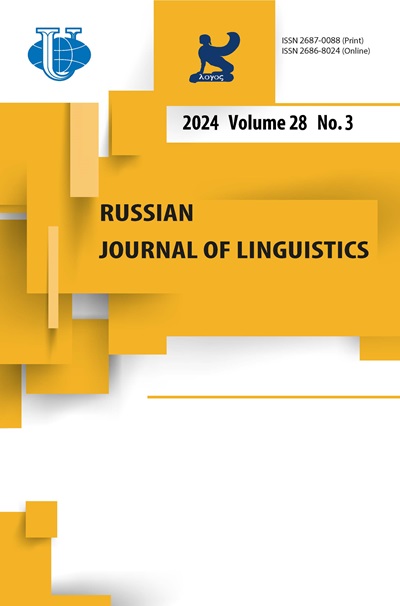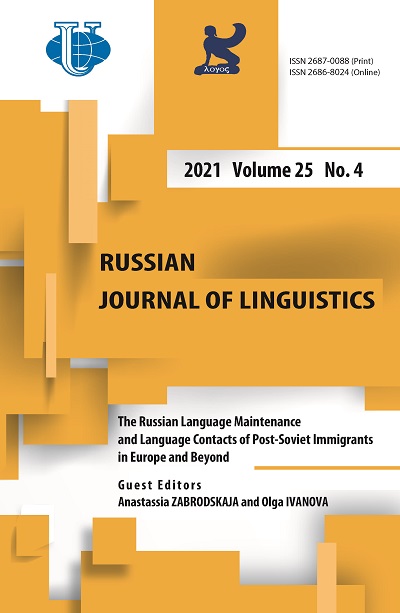Понимание украинского языка эстонцами через русский: структурные и экстралингвистические аспекты
- Авторы: Бранец А.1, Вершик А.2
-
Учреждения:
- Тартуский университет
- Таллинский университет
- Выпуск: Том 25, № 4 (2021): Сохранение русского языка и языковые контакты постсоветских иммигрантов в Европе и за ее пределами
- Страницы: 1071-1102
- Раздел: Статьи
- URL: https://journals.rudn.ru/linguistics/article/view/29737
- DOI: https://doi.org/10.22363/2687-0088-2021-25-4-1071-1102
Цитировать
Полный текст
Аннотация
В исследовании рассматривается, как люди используют и расширяют свои лингвистические ресурсы в ситуации, когда они владеют на некотором уровне вторым языком и пытаются понять третий язык, близкородственный второму языку. Основное внимание в исследовании уделяется пониманию украинского языка с помощью некоторого знания русского носителями эстонского как первого языка. Эта ситуация называется опосредованным рецептивным многоязычием. Целью данного исследования является изучение роли межъязыкового сходства (объективного или предполагаемого, в терминах Ringbom 2007) и экстралингвистических факторов для правильного понимания. Помимо измерения уровня успеха, мы анализируем точку зрения респондентов. Эксперимент был проведен с 30-ю носителями эстонского как первого языка и включал опросник, C-тест на знание русского языка, три украинских текста с различными группами заданий и интервью. В этой статье мы делаем акцент на группе заданий по определению значения украинских слов из текстов, а также на интервью. Результаты показали, что сходство, воспринимаемое или объективное, не является единственным решающим фактором, способствующим пониманию. Объяснения участников подтвердили наши предыдущие выводы о том, что сходство, хотя и играет важную роль, лишь частично отвечает за правильное понимание. Это выяснилось на основе интервью. Во многих случаях на выбор участников влиял ряд экстралингвистических факторов, таких как общие знания, контекст, знакомство с различными регистрами русского языка, фактор многоязычия (М-фактор), металингвистическая сознательность и обучаемость. В некоторых случаях контекст и общие знания перевешивали роль сходства. Результаты показывают, как сходство языков в совокупности с экстралингвистическими факторами способствуют успешному пониманию в сложных ситуациях многоязычия.
Об авторах
Анна Бранец
Тартуский университет
Автор, ответственный за переписку.
Email: anna.branets@ut.ee
ORCID iD: 0000-0002-7599-2169
магистр языкознания, аспирант
Тарту, ЭстонияАнна Вершик
Таллинский университет
Email: annave@tlu.ee
ORCID iD: 0000-0003-3989-0146
профессор общего языкознания
Таллин, ЭстонияСписок литературы
- Backus, Ad. 2014. Towards a usage-based account of language change: Implications of contact linguistics for linguistic theory. In Robert Nicolaï (ed.), Questioning Language Contact: Limits of Contact, Contact at its Limits, 91-118. Leiden: Brill. https://doi.org/10.1163/9789004279056
- Bahtina, Daria & Jan D. ten Thije. 2012. Receptive multilingualism. In Carol A. Chapelle (ed.), The Concise Encyclopedia of Applied Linguistics, 4899-4904. WILEY Blackwell. https://doi.org/10.1002/9781405198431.wbeal1001
- Bahtina-Jantsikene, Daria. 2013. Mind Your Languages: Lingua Receptiva in Estonian-Russian Communication. Utrecht: LOT
- Bahtina-Jantsikene, Daria & Ad Backus. 2016. Limited common ground, unlimited communicative success: An experimental study into Lingua Receptiva using Estonianand Russian. Philologia Estonica Tallinnensis 1, 17-36. https://doi.org/10.22601/PET.2016.01.03
- Barlow, Michael & Suzanne Kemmer (eds.). 2000. Usage-Based Models of Language. Stanford, Calif: CSLI Publications.
- Berthele, Raphael. 2007. 5th Sieve: Syntactic structures. In Britta Hufeisen & Nicole Marx (eds.), EuroComGerm - Die sieben Siebe. Germanische Sprachen lesen lernen, 167-180. Aachen: Shaker Verlag.
- Berthele, Raphael. 2008. Dialect-standard situations as embryonic Multilingualism. Findings on the inter-lingual potential of provinces. Sociolinguistica 22 (1). 87-107. https://doi.org/10.1515/9783484605299.87
- Blees, Gerda J. & Jan D. ten Thije. 2016. Receptive multilingualism and awareness. In Jasone Cenoz, Durk Gorter & Stephen May (eds.), Language Awareness and Multilingualism, 333-345. Springer. https://doi.org/10.1007/978-3-319-02325-0_25-2
- Blommaert, Jan & Ad Backus. 2011. Repertoires revisited: ‘Knowing language’ in superdiversity. Working Papers in Urban Language & Literacies 67. London, England: King's College.
- Branets, Anna & Ad Backus. 2020. L2 knowledge facilitating L3 learning: The role of Russian linguistic factors in understanding of Ukrainian by Estonians. Philologia Estonica Tallinnensis 5. 59-86.
- Branets, Anna & Daria Bahtina. 2021 The Role of Language Exposure in Mediated Receptive Multilingualism - Lähivõrdlusi. Lähivertailuja 31. 60-89.
- Branets, Anna, Daria Bahtina & Anna Verschik. 2020. Mediated receptive multilingualism: Estonian Russian-Ukrainian case study. Linguistic Approaches to Bilingualism 10 (3). 380-411. https://doi.org/10.1075/lab.17079.ver
- Braunmüller, Kurt. 2007. Receptive multilingualism in Northern Europe in the Middle Ages: A description of a scenario. In Jan D. ten Thije & Ludger Zeevaert (eds.), Receptive Multilingualism, 25-47. Amsterdam: John Benjamins. https://doi.org/10.1075/hsm.6.04bra
- Bybee, Joan. 2010. Language, Usage and Cognition. Cambridge: Cambridge University Press.
- Cenoz, Jasone, Britta Hufeisen & Ulrike Jessner (eds.). 2001. Cross-Linguistic In uence in Third Language Acquisition: Psycholinguistic Perspectives. Clevedon, UK: Multilingual Matters.
- Cenoz, Jasone, Britta Hufeisen & Ulrike Jessner (eds.). 2003. The Multilingual Lexicon. Dordrecht: Kluwer.
- Croft, William. 2001. Radical Construction Grammar. Syntactic Theory in Typological Perspective. Oxford: OUP.
- Dewaele, Jean-Marc. 1998. Lexical inventions: French interlanguage as L2 versus L3. Applied Linguistics 19. 471-490.
- Giles, Howard, Nikolas Coupland & Justine Coupland. 1991. Accommodation theory: Communication, context and consequence. In Howard Giles, Nikolas Coupland & Justine Coupland (eds.), Contexts of Accommodation: Developments in Applied Sociolinguistics, 1-68. Cambridge: Cambridge University Press
- Golubovic, Jelena. 2016. Mutual Intelligibility in the Slavic Language Area. Dissertation in Linguistics (152). Groningen: University of Groningen.
- Gooskens, Charlotte. 2006. Linguistic and extra-linguistic predictors of inter-Scandinavian intelligibility. Linguistics in the Netherlands 23 (1). 101-113.
- Gooskens, Charlotte. 2007a. The contribution of linguistic factors to the intelligibility of closely related languages. Journal of Multilingual and Multicultural Development 28 (6). 445-467.
- Gooskens, Charlotte. 2007b. Contact, attitude and phonetic distance as predictors of inter-Scandinavian communication. Near languages - Collateral languages. Actes du Colloque International Réuni à Limerick, du 16 au 18 juin 2005. 99-109
- Gooskens, Charlotte. 2013. Experimental methods for measuring intelligibility of closely related language varieties. In Robert Bayley, Richard Cameron & Ceil Lucas (eds.), Handbook of Sociolinguistics, 195-213. Oxford: Oxford University Press
- Gooskens, Charlotte & Wilbert Heeringa. 2014. The role of dialect exposure in receptive multilingualism. Applied Linguistics Review 5 (1). 247-271. https://doi.org/10.1515/applirev-2014-0011
- Gooskens, Charlotte, Wilbert Heeringa & Karin Beijering. 2008. Phonetic and lexical predictors of intelligibility. International Journal of Humanities and Arts Computing 2 (1-2). 63-81. https://doi.org/10.3366/E1753854809000317
- Gooskens, Charlotte & Cindy Schneider. 2019. Linguistic and non-linguistic factors affecting intelligibility across closely related varieties in Pentecost Island, Vanuatu. Dialectologia 23. 61-85
- Gooskens, Charlotte, Renée van Bezooijen & Vincent J. van Heuven. 2015. Mutual intelligibility of Dutch German cognates by children: The devil is in the detail. Linguistics 53 (2). 255-283. https://doi.org/10.1515/ling-2015-0002
- Gooskens, Charlotte & Vincent J. van Heuven. 2017. Measuring cross-linguistic intelligibility in the Germanic, Romance and Slavic language groups. Speech Communication 89. 25-36. https://doi.org/10.1016/j.specom.2017.02.008
- Gooskens, Charlotte & Vincent J. van Heuven. 2019. How well can intelligibility of closely related languages in Europe be predicted by linguistic and non-linguistic variables? Linguistic approaches to bilingualism 10 (3). 351-379. https://doi.org/10.1075/lab.17084.goo
- Grosjean, François. 1998. Studying bilinguals: Methodological and conceptual issues. Bilingualism: Language and Cognition 1. 131-149
- Grotjahn, Rüdiger. 1987. How to construct and evaluate a C-test: A discussion of some problems and some statistical analyses. In Rüdiger Grotjahn, Christine Klein-Braley & Douglas K. Stevenson (eds.), Taking Their Measure: The Validity and Validation of Language Tests, 219-253. Bochum: Brockmeyer
- Härmävaara, Hanna-Ilona. 2014. Facilitating mutual understanding in everyday interaction between Finns and Estonians. Applied Linguistics Review 5 (1). 211-245.
- Härmävaara, Hanna-Ilona & Charlotte Gooskens. 2019. Mutual intelligibility of Finnish and Estonian vocabulary. Lähivõrdlusi. Lähivertailuja 29. 13-56. https://doi.org/10.5128/LV29.01
- Haugen, Einar. 1953. The Norwegian Language in America. A study in Bilingual Behavior. Philadelphia: University of Pennsylvania Press.
- Haugen, Einar. 1966. Semicommunication: The language gap in Scandinavia. Sociological Inquiry 36 (2). 280-297. https://doi.org/10.1111/j.1475-682X.1966.tb00630.x
- Haugen, Einar. 1981. Interlanguage. In Einar Haugen (ed.) (1987), Blessings of Babel. Bilingualism and Language Planning, 77-81. Berlin: Mouton de Gruyter.
- Hlavac, Jim. 2014. Receptive multilingualism and its relevance to translation studies with data from interpreters of the Bosnian, Croatian and Serbian languages. Across Languages and Cultures 15 (2). 279-301. https://doi.org/10.1556/Acr.15.2014.2.6
- Jarvis, Scott & Aneta Pavlenko. 2008. Crosslinguistic In uence in Language and Cognition. New York & London: Routledge
- Jessner, Ulrike. 2014. On multilingual awareness or why the multilingual learner is a specific language learner. In Mirosław Pawlak & Larissa Aronin (eds.), Essential Topics in Applied Linguistics and Multilingualism. Studies in Honour of David Singleton, 175-184. Heidelberg: Springer. https://doi.org/10.1007/978-3-319-01414-2_10
- Kaivapalu, Annekatrin & Pirkko Muikku-Werner. 2010. Receptive multilingualism: How Finnish as a first language helps learners to understand Estonian? Lähivertailuja. Lähivõrdlusi 20. 68-97. http://dx.doi.org/10.5128/LV20.03
- Kaivapalu, Annekatrin. 2015. Mutual comprehension of Estonian and Finnish Context-Free Words and Texts: Linguistic Determinants, comprehension Process and Symmetry. Eesti Rakenduslingvistika Ühingu aastaraamat 11. 55-74. https://doi.org/10.5128/ERYa11.04
- Kaivapalu, Annekatrin & Maisa Martin. 2007. Morphology in transition: Plural inflection of Finnish nouns by Estonian and Russian learners. Acta Linguistica Hungarica - ACTA LINGUIST HUNG 54. 129-156. https://doi.org/10.1556/ALing.54.2007.2.2
- Kaivapalu, Annekatrin & Maisa Martin. 2017. Perceived similarity between written Estonian and Finnish: Strings of letters or morphological units? Nordic Journal of Linguistics 40 (2). 149-174. https://doi.org/10.1017/S0332586517000142
- Langacker, Ronald W. 1987. Foundations of Cognitive Grammar. Vol. 1: Theoretical Prerequisites. Stanford: Stanford University Press
- Lüdi, Georges. 2007. The Swiss model of plurilingual communication. In Kristin Bührig & Jan D. ten Thije (eds.), Beyond Misunderstanding: Linguistic Analyses of Intercultural Communication, 159-178. Amsterdam: John Benjamins
- Lüdi, Georges. 2013. Receptive multilingualism as a strategy for sharing mutual linguistic resources in the workplace in a Swiss context. International Journal of Multilingualism 10 (2). 140-158
- Muikku-Werner, Pirkko. 2013. Understanding Estonian texts on a Finnish language base. - Lähivertailuja. Lähivõrdlusi 23. 210-237. https://doi.org/10.5128/LV23.09
- Muikku-Werner, Pirkko. 2014. Co-text and receptive multilingualism - Finnish students comprehending Estonian. Eesti Ja Soome-Ugri Keeleteaduse Ajakiri. Journal of Estonian and Finno-Ugric Linguistics 5 (3). 99-113. https://doi.org/10.12697/jeful.2014.5.3.05
- Quick, Antje Endesfelder & Anna Verschik. 2019. Usage-based contact linguistics: An introduction to the special issue. Applied Linguistics Review. https://doi.org/10.1515/applirev-2019-0026
- Rehbein, Jochen Jan D. ten Thije & Anna Verschik. 2012. Lingua receptiva (LaRa) - remarks on the quintessence of receptive multilingualism. International Journal of Bilingualism 16 (3). 248-264. https://doi.org/10.1177/1367006911426466
- Ringbom, Håkan & Scott Jarvis. 2009. The importance of cross-linguistic similarity in foreign language learning. In Michael H. Long & Catherine. J. Doughty (eds.), Handbook of Language Learning, 106-118. Oxford: Blackwell
- Ringbom Håkan. 2007. Cross-Linguistic Similarity in Foreign Language Learning. Clevedon: Multilingual Matters
- Salehi, Mohammad & Aydin Neysani. 2017. Receptive intelligibility of Turkish to Iranian-Azerbaijani speakers. Cogent Education 4 (1). https://doi.org/10.1080/2331186X.2017.1326653
- Schüppert, Anja & Charlotte Gooskens. 2011. Investigating the role of language attitudes for perception abilities using reaction time. Dialectologia: Revista Electrònica. 119-140
- Selinker, Larry & Beatrice Baumgartner-Cohen. 1995. Multiple language acquisition: ‘Damn it, why can’t I keep these two languages apart?’ Multilingualism and Language Learning 8 (2). 115-123
- Sherkina-Lieber, Marina. 2015. Tense, aspect, and agreement in heritage Labrador Inuttitut: Do receptive bilinguals understand functional morphology? Linguistic Approaches to Bilingualism 5 (1). 30-61. https://doi.org/10.1075/lab.5.1.02she
- Shumarova, Natalia. 2000. Individual Linguistic Competence in the Situation of Bilingualism. Kyiv: Видавничий центр КДЛУ. (In Ukranian)
- Swarte, Femke, Anja Schüppert & Charlotte Gooskens. 2013. Do speakers of Dutch use their knowledge of German while processing written Danish words? Linguistics in the Netherlands 30 (1). 146-159. https://doi.org/10.1075/avt.30.11swa
- ten Thije, Jan D. & Ludger Zeevaert (eds.). 2007. Receptive Multilingualism. Amsterdam: John Benjamins. https://doi.org/10.1075/hsm.6
- ten Thije, Jan D., Charlotte Gooskens, Frans Daems, Leonie Cornips & Mieke Smits. 2017. Lingua receptiva: Position paper on the European Commission’s Skills Agenda. European Journal of Applied Linguistics 5 (1). 141-146. https://doi.org/10.1515/eujal-2017-0003
- Tomasello, Michael. 2003. Constructing a Language: A Usage-Based Theory of Language Acquisition. Cambridge, MA: Harvard University Press
- Tyshchenko, Kostyantyn. 2010. Pan-Slavic components of Ukrainian. Ternopil: Мандрівець: всеукраїнський науковий журнал 3. 65-75
- Verschik, Anna. 2012. Practicing receptive multilingualism: Estonian-Finnish communication in Tallinn. International Journal of Bilingualism 16 (3). 265-286. https://doi.org/10.1177/1367006911426465
- Verschik, Anna. 2017. Language contact, language awareness, and multilingualism. In Jasone Cenoz, Durk Gorter & Stephnen May (eds.), Language Awareness and Multilingualism, 1-13. Springer
- Voegelin, Charles F. and Zellig S. Harris. 1951. Methods for determining intelligibility among dialects of natural languages. Proceedings of the American Philosophical Society 95. 322-329
- Zeevaert, Ludger. 2004. Interscandinavian Communication. Strategies for Establishing Understanding between Scandinavians in Discourse. Hamburg: Dr. Kovač. http://www.luistertaal.nl/en/ (accessed 15.11.2021)

















